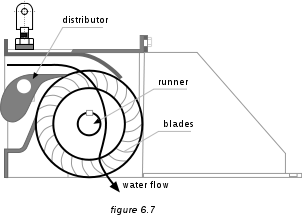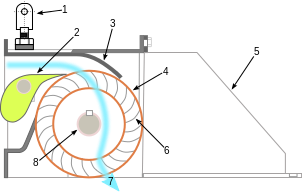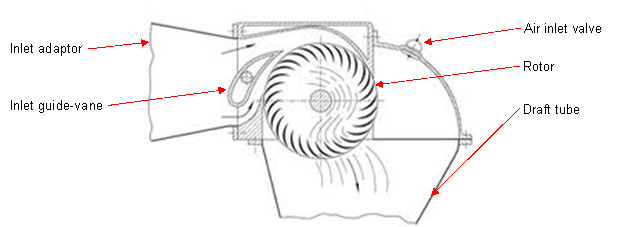The Cross-flow turbine is a hydro turbine constructed and developed by Anthony Michell, Donát Bánki, and the Fritz Ossberger. The turbine was first introduced by Michell in 1903, and several years later, Ossberger registered the Cross-flow turbine in the company he founded. That is why this turbine is sometimes called the Bánki-Michell turbine or Ossberger turbine.
Cross-flow turbines are classified into a set of impulse turbines. The most important reason for such a classification is that these turbines operate in the air and do not submerse like reaction turbines. The set operates at atmospheric pressure. They are suitable for a wide range of heads and powers. Working in heads between 1.75 to 200 meters and power between 5 to 100 kW and at higher scales, up to 3 MW of these turbines has left a flexible machine in mind. However, these turbines are usually used in heads under 40 meters and for fewer powers. The average flow at which these turbines operate is from 40 to 5000 liters per second.
Working principle of a Cross-flow Turbine
The naming of Cross-flow turbines is based on the way they work. This section explains how these turbines work and why they are given this name.
Water flows after passing through the guide vanes to the rotor on the blades at the top of the rotor. It then flows across the turbine from the center of the turbine and creates a torque on the blades of the lower part. This type of fluid flow across the turbine has been the reason for naming Cross-flow turbines.
The figure below shows the fluid flow path after entering the turbine to exit. About three-quarters of the output power is obtained in the first stage when water hits the upper blades of the rotor, and the remaining quarter is generated in the second stage.

The steps that the water flow takes to pass through the turbine and in the meantime generate power are as follows.
- Water flow enters the turbine housing through the inlet adapter. This adapter is responsible for supplying water from a circular inlet to a rectangular one.
- After the adapter, water flows to the guide vanes. Two guide vanes are usually present before the runner cylinder to direct the water flow to the vanes at a suitable angle. The guide vanes may stop the water supply when the flow is low by suitable sealing to the turbine casing.
- The water reaches the rotor, which rotates around a horizontal axis. Water moves across the turbine blades and flows first from the outside of the turbine to the inside, and then, from inside the rotor to the outside of that. It then falls out of the turbine.
- The outlet water fills the draft tube from the bottom of the rotor to the level of the discharge water. The water flows into the draft tube and from there is directed out of the turbine downstream.
The above steps are the main stages of power exchange between the water and the turbine. Other equipment is to facilitate the above steps. An explanation of this equipment will be provided in the next section. Also, you can watch this schematic video to learn more about how fluid flows in a Cross-flow turbine.
Components of a Cross-flow Turbine
The following figure shows the main components of a Cross-flow turbine. With regard to the numbering on the figure, we have a description of the operation of these components as follows.

Watch Video About cross-flow turbine
1- Air Inlet Valve
This valve is needed to adjust the proper amount of air entering the turbine. If more than necessary, the suction head is reduced and consequently the efficiency is dropped. If this inlet air is less than necessary, the water flow in the tube draft will increase, the runner will drown and the efficiency will decrease again.
2- Guide Vane or Distributer
This part has two important functions; one is to provide the right angle for the fluid flow to hit the blades, and the other is to adjust the flow rate to the runner according to the turbine load. Water flow can be directed to the rotor from the over and below of the guide vanes.
3- Casing (Gray Line)
This part is placed to direct the water flow inside the turbine chamber to prevent water from splashing out. Proper sealing of the guide vane to this section is also important in water flow cut-off operations when necessary.
4- Runner
The turbine consists of a drum-shaped cylindrical water rotor, to which a number of blades are mounted radially and tangentially. The turbine shaft in the center is horizontal. The rotor is usually made with different diameters from 10 cm to 50 cm in steps of 10 cm. Smaller diameters are used for sites with higher heads. Rotators with a length of 2.5 and 5 meters and a diameter of 30 cm are usually used for low heads. For situations with very low heads, 40 and 50 cm rotors are installed.
5- Rear Casing
This part is normally for hardware protection of the turbine structure, which is removable.
6– Blades
The turbine blades are mounted on a rotating cylinder for the mechanism of power transfer from the kinetic energy of water to the turbine, the number of which can be up to 37. The blades are usually made up of stainless steel. The ends of the blades are welded to the discs. A blade is formed as a cross-section of a circle.
7- Water Flow
In the previous section, the water flow path inside the Cross-flow turbine was explained in detail. The point that is important to address in this section is the draft tube and its important role in the operation of the turbine.
As you can see in the figure below, at the bottom of the turbine is the draft tube. Water enters the draft tube after leaving the rotor. This tube can be several meters long; so that it does not exceed 1/3 of the net head of the hydropower plant. The function of the draft tube is to maximize the suction head; in such a way that the long draft tube causes the structure of the turbine to move upwards much above the discharge level.

8- Shaft
The axial shaft is a part of the main structure of the cross-flow turbine. In a set of Cross-flow turbine, a single shaft is generally used for two separate rotors that have the same diameter but different lengths. Connecting the rotating shaft to the generator converts mechanical motion into electrical power.
The rotor usually rotates slower than the generator. Therefore, a gearbox or a belt-drive is used to convert the speeds. For larger hydro powers, an intermediate shaft is also used to facilitate the balance of radial forces acting on the components.
You can see the different parts of a Cross-flow turbine in the video here.
Advantages of Cross-flow Turbines
Maintaining efficiency over a wide range of flow rates
One of the advantages of cross-flow turbines is the operation in a wide range of flow rates while maintaining efficiency. This is because these turbines usually have two guide vanes; one covers one-third of the width of the entrance and the other two-thirds. When the flow rate is low, the guide vane is open with 1/3 of the inlet width and the other is closed; for medium flow rates, the opposite is true, and finally, for high flow rates, both guide vanes pass the water.
The following figure shows the flow-efficiency curve for a Cross-flow turbine in different operating modes of the two guide vanes. As can be seen in this diagram, the efficiency curve of these turbines is flat, and therefore, they can maintain their efficiency in a wide range (from about 1/6 to full load) of flows. Even at about 1/5 of full loads, the efficiency remains above 50%.
The flat characteristic curve of these turbines has recorded a successful performance of these turbines at partial loads. Especially, for periods of the year when the river water level is low.
However, their efficiency is not as high as other conventional turbines such as Pelton or Francis. So, in hydropower sites with a Cross-flow turbine efficiency of about 82% is a good value.

Simple and Low-Cost Maintenance
Cross-flow turbines require low maintenance because of the simplicity of the system. Lubrication of the two rotor bearings is usually done once a month. A Cross-flow turbine usually operates for about 40 years without any problems; as the oldest case of this turbine is now about 60 years that is well present in the hydropower site. The major use of these turbines is in micro and mini hydro powerplants with capacities of less than 2000 kW, and this is due to their low price and easier maintenance.
Self-Cleaning
Another advantage of these turbines is that they are self-cleaning. This means that debris that inadvertently enters the turbine, after striking the upper blades, reaches the lower ones with the flow of water and from there, is thrown out of the turbine due to centrifugal forces.
Read More on Linquip



